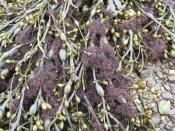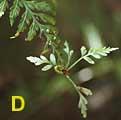The Structure of Ferns
Ferns and flourish plants are so-called 'higher' plants which differ from the 'low' plants, for example, mosses and mushrooms by there construcion. They consist of 3 basic organs, the root, shoot or trunk and leaf. Our open land ferns are hardy herbaceous plants which lost their leaves either in autumn or are winter-green or evergreen. They grow from a rhizom which is like most ferns more or less arising erect above the ground. Some species also form short creeping rhizoms, spread out over a single location. Few species , as for example the Ostrich fern (Matteuccia strutiopteris), can become annoyingas they grow metre long underground rhizomes, sometimes.
The leaves call frond with the fern, consisting of stipe and lamina. The ferns surprise by many different forms and colors which reach from redly, light green, dark green to yellowish green. Reproduction takes place around the spores, in contrast to the flourish plants which reproduce by seed. The spores of ferns are produced on the underside of the fronds, combined in
groups within a spore case (sporangium). The sporangia stand together in groups (sori) sometimes covered with a veil (indusium). With some fern species the spores are produced at separate fronds, which often differ from the normal fronds a lot, for example with the Royal fern (Osmunda regalis), Sensitiv fern (Onoclea sensibilis) and Ostrich fern (Matteuccia strutiopteris). The spores mature mostly between July and November and are spread by the wind. With promising conditions, they develop themselves from the spores then become green thin flat growth, known prothallus, where the male and feminine genital organs are found. With enough humidity the conception takes place on the prothallus and it developes onto itself a young fern plant. A regular change finds it between a sexual generation (prothallus) and an...


